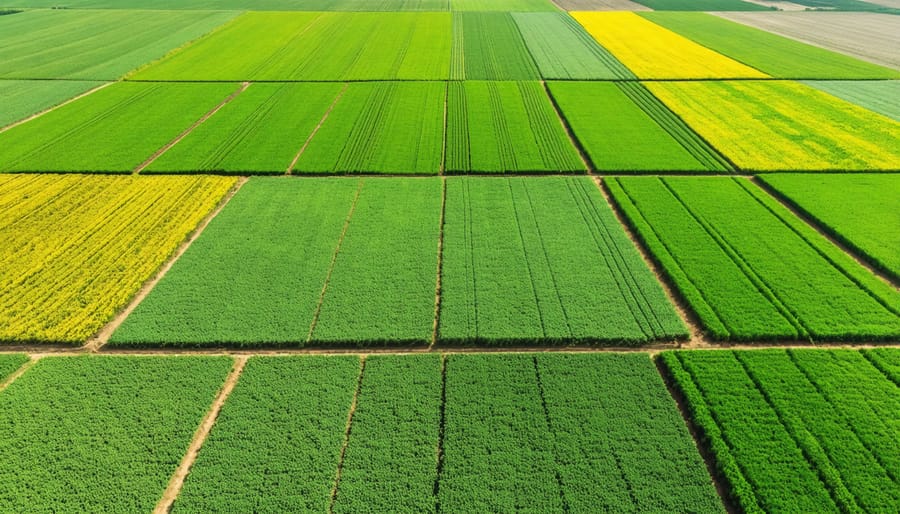# Crop Sustainability: The Foundation of Agricultural Real Estate Value
Sustainable farming practices directly increase property values by 15-25% compared to conventional operations, making crop sustainability a critical consideration for agricultural real estate investors and property owners. When farmland demonstrates long-term soil health, water conservation measures, and biodiversity management, it commands premium prices and attracts quality tenants willing to pay higher lease rates.
**Align insurance coverage with sustainability certifications.** Properties enrolled in organic, regenerative, or certified sustainable programs require specialized insurance products that recognize reduced input costs, premium crop pricing, and enhanced soil resilience. Traditional policies often undervalue these benefits, leaving significant asset protection gaps.
**Structure coverage to protect transition investments.** The 3-7 year conversion period to sustainable practices represents substantial financial exposure. Insurance strategies must account for yield variability, market access development, and certification compliance costs during this vulnerable phase when properties may not yet realize premium returns.
**Leverage sustainability as risk mitigation.** Insurers increasingly recognize that sustainable crop management reduces long-term claim frequency through improved soil water retention, enhanced pest resistance, and climate adaptation. This translates to premium reductions of 10-20% for properly documented sustainable operations, directly improving investment returns.
**Document practices for valuation advantages.** Comprehensive records of cover cropping, reduced tillage, integrated pest management, and nutrient cycling create tangible evidence of asset improvement, supporting higher appraisals and favorable lending terms for agricultural property portfolios.
Why Crop Sustainability Matters to Your Property Portfolio

The Real Estate Value of Sustainable Farmland
Sustainable farmland is rapidly becoming a premium asset class in agricultural real estate markets. Properties with documented sustainable practices—including soil conservation, water management systems, and organic certifications—consistently command 10-20% higher sale prices compared to conventionally managed land. This value premium stems from multiple factors that savvy investors recognize.
First, sustainable practices preserve and enhance soil health, which directly impacts long-term productivity and reduces input costs. Buyers understand that fertile, well-managed soil represents decades of value that conventional farming may have depleted. Second, properties with sustainability certifications offer immediate access to premium crop markets and government incentive programs, creating additional revenue streams that boost overall property valuations.
From a real estate investment perspective, sustainable farmland also demonstrates lower operational risk profiles. These properties typically feature diversified income potential, reduced dependency on expensive chemical inputs, and greater resilience against climate-related disruptions—all factors that make lenders more favorable and insurance premiums more competitive.
For property investors, the marketability advantage is equally compelling. As institutional investors and conservation-minded buyers increasingly seek sustainable agricultural assets, properties with established green credentials enjoy shorter market times and attract more qualified buyers willing to pay premium prices.
Risk Reduction Through Sustainable Practices
Sustainable farming practices serve as a powerful shield against some of agriculture’s most costly threats. When farmers adopt methods like crop rotation, cover cropping, and integrated pest management, they’re essentially building insurance into their land itself. These approaches dramatically reduce the risk of catastrophic crop failures that can devastate property values and create financial liability.
Think of soil health as the foundation of your property investment—literally. Conventional farming methods can deplete soil nutrients and structure within just a few decades, but sustainable practices actively rebuild and protect this critical asset. Properties with degraded soil face expensive remediation costs and diminished marketability, making property risk management essential for agricultural holdings.
From an insurance and investment standpoint, sustainable farms present lower risk profiles. They’re less vulnerable to extreme weather events, pest infestations, and regulatory penalties for environmental violations—all factors that can trigger insurance claims or reduce property equity. Many insurers now recognize this reduced risk exposure, offering preferential rates and specialized coverage options for certified sustainable operations. For real estate investors and landowners, embracing sustainability isn’t just environmentally responsible; it’s a strategic move that protects long-term asset value while potentially lowering insurance premiums.
Understanding Sustainable Agriculture Insurance: Beyond Traditional Crop Coverage
What Makes Insurance ‘Sustainable’?
Sustainable agriculture insurance goes beyond traditional crop coverage by recognizing and rewarding farming practices that protect the environment while maintaining property value. These specialized policies acknowledge that sustainable operations—think reduced chemical use, soil conservation, and water management—actually reduce long-term risks.
What sets these products apart? They incorporate coverage features specifically designed for eco-friendly operations. For instance, many policies now include transition coverage, which protects farmers during the critical conversion period to organic or regenerative practices when yields might temporarily dip. Some insurers offer premium discounts for implementing conservation techniques like cover cropping or precision agriculture technology that minimize environmental impact.
Additionally, sustainable policies often provide specialized protection for ecosystem services revenue streams—such as carbon credit programs or conservation easements—that traditional policies overlook. This matters for property investors because sustainable certifications and practices increasingly influence farmland valuations and marketability.
For real estate professionals advising agricultural clients, understanding these distinctions is crucial. Properties with sustainable insurance coverage demonstrate a commitment to long-term land stewardship, which appeals to environmentally conscious buyers and can justify premium pricing in competitive markets.
Coverage Gaps in Traditional Policies
Traditional crop insurance policies, while valuable for protecting against immediate yield losses, often fall short when it comes to supporting sustainable farming practices and long-term land health. Understanding these coverage gaps is crucial for agricultural property investors looking to maintain and enhance their asset values over time.
Most conventional policies focus solely on short-term production metrics—bushels per acre or immediate weather damage—without considering the broader picture of soil health, ecosystem services, or regenerative practices. If you invest in cover cropping, reduced tillage, or crop rotation to build soil organic matter, standard policies won’t reward these sustainability investments. In fact, they might even penalize you during the transition period when yields temporarily dip as your land adapts to new practices.
Water conservation infrastructure, biodiversity enhancements, and carbon sequestration efforts typically receive zero recognition in traditional coverage formulas. This creates a disconnect: while these practices increase your property’s long-term resilience and market value, they’re invisible to most insurers. Additionally, standard policies rarely account for the reduced input costs and improved drought resistance that sustainable methods deliver, leaving a significant protection gap for forward-thinking agricultural property owners who understand that land health directly impacts real estate values.
Insurance Strategies That Support Crop Sustainability
Premium Incentives for Sustainable Practices
Insurance carriers increasingly recognize that sustainable farming practices reduce risk—and they’re putting their money where their mouth is. If you’re investing in agricultural property or managing farmland, implementing practices like cover cropping, crop rotation, and soil conservation methods can unlock meaningful premium discounts on your agricultural insurance policies.
Think of it this way: fields protected by cover crops experience less erosion, maintain better soil structure, and demonstrate improved water retention—all factors that reduce claim likelihood. Insurers reward this reduced risk profile with premium reductions typically ranging from 5% to 15%, depending on the comprehensiveness of your sustainability program.
Crop rotation strategies similarly appeal to underwriters because they naturally break pest and disease cycles, reducing catastrophic loss potential. Conservation tillage methods that preserve topsoil integrity further demonstrate responsible land stewardship that translates to lower insurance costs.
For real estate investors evaluating agricultural properties, these premium incentives represent more than just cost savings—they’re indicators of long-term property value protection. Properties with established sustainable practices often command higher resale values while simultaneously reducing operational insurance expenses, creating a compelling dual benefit that strengthens your investment portfolio’s bottom line.
Whole-Farm Revenue Protection
Traditional crop insurance often focuses on single commodities, leaving sustainable farmers who rotate crops or maintain diversified operations at a disadvantage. Whole-Farm Revenue Protection (WFRP) changes this dynamic by insuring the entire farm operation rather than individual crops—a game-changer for property investors backing sustainable agriculture.
This comprehensive policy covers all your farm’s commodities and livestock under one umbrella, protecting the total revenue stream. For landowners with tenants practicing crop rotation, cover cropping, or polyculture systems, WFRP provides the financial safety net that conventional single-crop policies simply can’t offer.
The beauty of WFRP lies in its recognition that sustainable farming is inherently diverse. If one crop underperforms due to weather or market conditions, your insurance coverage accounts for revenue from all sources combined. This approach not only protects your investment but also encourages farming practices that improve soil health and long-term property value.
For real estate investors, WFRP-insured properties become more attractive to quality tenants committed to sustainable practices, potentially commanding higher lease rates while preserving the land’s productivity for generations.
Soil Health and Carbon Credit Insurance
As agricultural property owners increasingly invest in regenerative farming practices, a new category of insurance products has emerged to protect these sustainability initiatives. Soil health and carbon credit insurance represents a cutting-edge financial tool that safeguards your investment in long-term land improvement strategies—much like how traditional property insurance protects your physical assets.
These specialized policies address a unique challenge: what happens if your carbon sequestration program fails to meet certification standards, or if soil improvement efforts don’t yield the expected results? For landowners participating in carbon credit markets—where healthy soil can generate tradable credits worth $15-30 per acre annually—this protection becomes essential. Insurance products now cover risks like carbon credit verification failures, unexpected soil contamination, or loss of organic certification that could derail years of careful land stewardship.
From a real estate investment perspective, these policies serve dual purposes. They protect revenue streams from carbon markets while preserving the enhanced property value that comes with documented soil health improvements. Properties with certified carbon sequestration programs often command premium prices, and this insurance ensures those value-adds remain intact even when Mother Nature doesn’t cooperate.
The premiums typically range from 5-10% of projected carbon credit revenues, making them a relatively affordable way to de-risk sustainable agriculture investments. For farmland investors, this coverage transforms experimental sustainability practices into more bankable, insurable assets that lenders and buyers view favorably.

Financial Benefits: How Sustainability Insurance Improves Your Returns
Lower Premiums, Higher Property Values
Properties with documented sustainable farming operations and appropriate insurance coverage can command premium valuations in today’s market. Recent industry data shows agricultural real estate with certified sustainable practices sells for 7-12% above comparable conventional farmland. These sustainable insurance practices directly contribute to this appreciation by demonstrating reduced risk profiles to potential buyers and lenders.
Insurance premiums for sustainably managed cropland typically run 15-20% lower than conventional operations once sustainability certifications are established. This cost reduction stems from fewer claims related to soil erosion, water management issues, and weather-related crop failures. For a $500,000 agricultural property, this translates to annual savings of $1,500-$3,000 on insurance alone.
Beyond immediate savings, sustainable agriculture insurance creates a documented track record that enhances property marketability. Buyers increasingly seek farmland with established conservation practices and comprehensive risk management strategies. This demand premium, combined with lower operating costs, makes sustainable insurance an investment in both property protection and long-term asset appreciation.
Tax Credits and Deduction Opportunities
Agricultural property owners investing in sustainable farming practices can access several valuable tax advantages that strengthen both conservation efforts and overall portfolio returns. The federal government offers specific deductions for crop insurance premiums related to sustainable agriculture, which directly reduces your taxable income while protecting your farmland investment.
Conservation easements represent another powerful opportunity—if you’re preserving portions of agricultural property for environmental purposes, you may qualify for substantial income tax deductions based on the property’s appraised value. These easements can reduce estate taxes while maintaining the land’s productive capacity for future generations.
Equipment and infrastructure investments supporting sustainable practices, such as precision irrigation systems or renewable energy installations, often qualify for accelerated depreciation or Section 179 deductions. Additionally, certain soil and water conservation expenditures can be deducted immediately rather than capitalized, improving your cash flow position.
Keep in mind that insurance payouts themselves have distinct tax implications depending on the loss type and policy structure. Working with a tax professional experienced in agricultural real estate ensures you’re maximizing available credits while maintaining compliance. These incentives effectively lower the cost of protecting your sustainable agriculture investments, making conservation-minded farming more financially viable for property portfolios.

Evaluating Insurance Providers: What Agricultural Property Owners Should Look For
Key Policy Features and Red Flags
When evaluating sustainable agriculture insurance for your farmland investment, look for policies that specifically cover regenerative practices like cover cropping, reduced tillage, and integrated pest management. Essential features include premium discounts for implementing conservation measures, coverage for organic certification costs, and protection against yield losses during the transition to sustainable methods.
Red flags demand attention. Avoid policies with blanket exclusions for “experimental” farming techniques—this vague language can deny claims for legitimate sustainable practices. Watch for carriers unfamiliar with regenerative agriculture who may misclassify sustainable methods as risky. Suspiciously low premiums often signal inadequate coverage limits that won’t protect your property investment during catastrophic events.
Pay special attention to waiting periods for sustainability-related benefits and ensure loss adjustment procedures account for the longer-term nature of regenerative farming returns. Understanding policy terms is crucial—request clear definitions of “sustainable practices” and documentation requirements before signing. A reputable insurer will provide transparent coverage details and examples specific to your agricultural property type.
Questions to Ask Your Insurance Agent
Before committing to any sustainable agriculture insurance policy, arm yourself with the right questions. Start by asking, “What specific coverage do you offer for sustainable farming practices like cover cropping, rotational grazing, or organic certification?” This ensures your green initiatives won’t void claims.
Next, inquire about premium discounts: “How does implementing soil health practices or water conservation systems affect my rates?” Many insurers now reward sustainability with better pricing, directly impacting your property’s bottom line.
Don’t forget to ask, “What documentation do I need to prove my sustainable practices?” Understanding requirements upfront prevents claim denials later. Finally, question whether the policy covers “transition periods”—those crucial years when converting conventional farmland to sustainable methods, when yields may temporarily dip but your property value is positioning for long-term appreciation.
These targeted questions help you secure coverage that truly protects your agricultural real estate investment while supporting your sustainability goals.
Protecting your agricultural property investment requires more than just understanding sustainable farming practices—it demands a strategic approach that unites environmental stewardship with comprehensive insurance coverage. The intersection of crop sustainability and smart insurance decisions isn’t just about risk mitigation; it’s about enhancing property value, securing long-term returns, and positioning your farmland holdings for future success.
As you’ve seen throughout this guide, sustainable agriculture insurance strategies offer tangible benefits: reduced premium costs through eco-friendly certifications, enhanced property resilience against climate risks, and increased marketability to socially conscious buyers and tenants. These aren’t abstract concepts—they’re measurable advantages that directly impact your bottom line.
Now it’s time to take action. Start by conducting a sustainability audit of your agricultural properties to identify areas where environmental improvements could qualify you for specialized insurance products or premium discounts. Next, schedule consultations with insurance providers who specialize in agricultural property coverage and specifically ask about policies designed for sustainable operations. Request detailed comparisons showing how sustainability-focused coverage differs from conventional policies in both protection and cost.
Don’t overlook the importance of documentation. Maintain thorough records of sustainable practices implemented on your properties, from water conservation systems to soil health initiatives. These records become invaluable when negotiating insurance terms or demonstrating reduced risk profiles to underwriters.
Finally, make this an ongoing process rather than a one-time exercise. Agricultural sustainability and insurance markets continue evolving, presenting new opportunities for savvy real estate investors who stay informed and adaptable.